Exploring the Influence of Parking Penalties on Bike-Sharing System with Willingness Constraints: A Case Study of Beijing, China
Abstract
1. Introduction
2. Literature Review
2.1. Parking Spot System Layout Design
2.2. Parking Behaviors under Monetary Incentives
3. Methodology
3.1. Spot Radius Computation
3.2. Questionnaire Design
- The statistical chart presented above reveals several noteworthy characteristics regarding the usage behavior of bike-sharing users:
- Users who utilize bike-sharing for commuting purposes (60.37%) and connecting trips (44.24%) tend to engage in more inflexible journeys. In contrast, those who employ bike-sharing for leisure activities (24.42%) and shopping (8.29%) exhibit greater susceptibility to control restrictions.
- The majority of users (over 60%) utilize bike-sharing less than three times per week. This can be attributed to the increasing stringency of bike-sharing regulations, leading to restricted access in courtyards and parks, consequently diminishing its popularity.
- A significant portion of users (87.55%) utilize bike-sharing for trips lasting less than 20 min. This signifies that bike-sharing mainly serves as a mode of transportation for short to medium distances, complementing longer-distance travel options and competing with other short to medium-distance modes of transportation.
- Over 80% of users report a daily travel cost of less than CNY 4. This specific group’s characteristics are indicative of their sensitivity toward parking violation penalties, implying that fines may heighten users’ attention toward travel expenses.
4. Parking Behavior Promotion Balancing the Penalty and Willingness Constraints
4.1. Variable Analysis
- Female users exhibit a lower inclination to walk the additional distance for standard parking compared to male users (0.887 times). This discrepancy implies that gender-based physical differences contribute to varying levels of acceptance toward walking.
- Middle-aged and elderly users display a greater willingness to walk extra distances for standard parking compared to young users (1.65–1.70 times). This suggests that older users are more sensitive to fines and prefer to avoid penalties by investing more time in reaching designated parking spots.
- Freelancers exhibit a preference for the convenience offered by parking violations (0.083 times) compared to students and enterprise employees (1.827 times). Conversely, other professionals demonstrate a heightened sensitivity to punishment and opt for standard parking (4.231 times).
- High-income users demonstrate a decreasing probability of adhering to standard parking (0.470–0.480 times) compared to medium-income users (0.859 times), in contrast to low-income users. This trend suggests that individuals with higher incomes prioritize time and show reduced sensitivity to penalties.
- Users with slightly higher frequencies of bike-sharing display a lower willingness to walk extra distances for standard parking (0.862 times), indicating their readiness to incur fines in exchange for convenience during recreational trips. On the other hand, users with higher frequencies of bike-sharing are more likely to adhere to standard parking (1.706 times), implying that they encounter fewer parking violations during their daily commutes.
- Users with high expectations of convenience are less inclined towards standard parking, as they perceive bike-sharing to be more convenient than buses (0.850–0.865 times). In contrast, users with low expectations consider the convenience of bike-sharing to be comparable or even lower than that of buses, making them more willing to adhere to standard parking (1.360–5.560 times).
- The duration of each bike-sharing use and the maximum walking distance positively correlate with users’ inclination towards standard parking. As the bike-sharing system’s service level improves, increased satisfaction and loyalty promote a preference for standard parking. The cumulative percentage of the maximum walking distance is depicted in Figure 4, demonstrating a well-fitted exponential function with an impressive R2 value of 0.9888. In the absence of penalties, 80% of users are willing to accept a maximum limit of 400 m, while 40% can accept a limit of 800 m. The parking radius should not be excessively large for users with an average usage time of less than 15 min, typically engaged in short or connecting trips.
- The daily travel cost negatively correlates with users’ choice of standard parking. A decreased sensitivity to travel costs weakens the restraining effect of parking violation penalties. The positive normative impact of increased fines (2.216 times) outweighs the violation effect of an increased walking distance (0.998 times). This implies that increasing walking distance through well-designed punishment rules is feasible. When users’ daily travel costs amount to less than CNY 3, indicating a low expected price for bike-sharing, constraints imposed by cost considerations become more significant. Excessive penalties for parking violations may lead to user attrition.
4.2. Spot Radius without Penalty
- As the distance between spots increases, the likelihood of encountering a bike spot within that range increases. The probability of the existence of a bike spot experiences an initial rise followed by a subsequent decline. When the distance exceeds 800 m, the impact of the road network remains below 15%, indicating a commendable system stability in catering to fluctuations in traffic demand.
- The holistic service level of the bike-sharing system should adhere to the following guidelines: users possess a 75% chance of discovering a parking spot within a 300 m radius, and a 90% probability of securing a parking spot within a 450 m radius. The overall utilization efficiency is contingent on the spacing between spots: if the distance between spots is less than 400 m, the system efficiency is notably suboptimal; conversely, when the distance exceeds 800 m, the system efficiency surpasses 90%.
4.3. Stepwise Punishment Incentive
- The spacing between parking spots should be carefully determined, taking into account user walking distances. In the central urban area, the spacing should range from 400 m to 600 m, while in other areas, it can be extended from 600 m to 800 m. However, it is essential to avoid exceeding a maximum spacing of 1000 m. Furthermore, locating parking spots in open areas with high passenger flow is advisable to ensure accessibility.
- The penalty system for parking violations should incorporate credit scores and fines. Users who opt for standard parking should be rewarded with increased credit scores, allowing for minor deductions in the case of low-level parking violations. The severity of the penalty for parking violations should be determined based on the distance between the locking place and the nearest parking spot.
- With consistent walking distances, the proportion of standard parking decreases as the distance increases. This calls for stricter punishment and greater constraint. The regression coefficients of standard parking intention gradually diminish at different levels, indicating a diminishing effect of punishment on distance. At Level 5, the coefficient approaches horizontally, suggesting a diminished sensitivity to punishment regarding distance.
- While Level 5 punishment exhibits an effectiveness of over 85%, it is crucial to avoid low parking densities as they can result in substantial user attrition. Maintaining an adequate parking density in densely traveled areas is essential to ensure user willingness to utilize the bike-sharing system.
5. Conclusions
- Computation of bike-sharing spot density in Beijing, China: When considering the service level, users ought to be within a walking distance of 300 m to 450 m; however, to optimize utilization efficiency, this distance should exceed 400 m. In urban areas replete with dense travel, the interstitial spacing between bike-sharing parking points (twice the walking distance of users) should ideally fall between 400 m and 600 m, while in other travel areas, a range of 600 m to 800 m is recommended.
- Analysis of parameters in the parking constraint model: Among the various individual factors influencing parking behavior, it emerges that men, middle-aged and elderly individuals, those with restricted occupations, and individuals with modest incomes exhibit a heightened inclination toward standard parking. Pertaining to parking behavior factors, users characterized by frequent and vigorous usage patterns, low expectations of convenience, reduced travel costs, and flexible travel preferences manifest a heightened proclivity for standard parking. The cumulative percentage of users’ maximum acceptable walking distance evinces an exponential distribution, with approximately 80% of users amenable to a threshold of 400 m in the absence of penalties, while 40% evince acceptance of an upper limit of 800 m.
- A discernible quantitative association surfaces between the proportion of standard parking and penalty incentives across diverse walking distances, allowing for the inducement of walking distances via a stepwise penalization framework. Notably, within a walking distance of 300 m, the efficacy of regulations becomes apparent with escalating fines. As the walking distance expands, the constraining influence of moderate penalties gradually wanes. Reaching the echelons of higher fines once again engenders a constraint surpassing 85%, albeit at the expense of substantial user attrition. Consequently, judicious control over the minimum density of parking points assumes paramount importance to ensure the unwavering enthusiasm of users.
Author Contributions
Funding
Institutional Review Board Statement
Informed Consent Statement
Data Availability Statement
Acknowledgments
Conflicts of Interest
References
- Xiao, G.; Xiao, Y.; Ni, A.; Zhang, C.; Zong, F. Exploring Influence Mechanism of Bikesharing on the Use of Public Transportation—A Case of Shanghai. Transp. Lett. 2023, 15, 269–277. [Google Scholar] [CrossRef]
- Cheng, P.; Ou Yang, Z.; Liu, Y. Understanding Bike Sharing Use over Time by Employing Extended Technology Continuance Theory. Transp. Res. Part A Policy Pract. 2019, 124, 433–443. [Google Scholar] [CrossRef]
- Gao, K. Quantifying Economic Benefits from Free-Floating Bike-Sharing Systems: A Trip-Level Inference Approach and City-Scale Analysis. Transp. Res. Part A Policy Pract. 2021, 144, 89–103. [Google Scholar] [CrossRef]
- Arias-Molinares, D.; Xu, Y.; Büttner, B.; Duran-Rodas, D. Exploring Key Spatial Determinants for Mobility Hub Placement Based on Micromobility Ridership. J. Transp. Geogr. 2023, 110, 103621. [Google Scholar] [CrossRef]
- Wang, Y.; Yang, Y.; Wang, J.; Douglas, M.; Su, D. Examining the Influence of Social Norms on Orderly Parking Behavior of Dockless Bike-Sharing Users. Transp. Res. Part A Policy Pract. 2021, 147, 284–296. [Google Scholar] [CrossRef]
- Kaltenbrunner, A.; Meza, R.; Grivolla, J.; Codina, J.; Banchs, R. Urban Cycles and Mobility Patterns: Exploring and Predicting Trends in a Bicycle-Based Public Transport System. Pervasive Mob. Comput. 2010, 6, 455–466. [Google Scholar] [CrossRef]
- Rybarczyk, G.; Wu, C. Bicycle Facility Planning Using GIS and Multi-Criteria Decision Analysis. Appl. Geogr. 2010, 30, 282–293. [Google Scholar] [CrossRef]
- Xiao, G.; Lu, Q.; Ni, A.; Zhang, C. Research on Carbon Emissions of Public Bikes Based on the Life Cycle Theory. Transp. Lett. 2023, 15, 278–295. [Google Scholar] [CrossRef]
- Li, L.; He, S.; Zhang, J.; Ran, B. Short-term Highway Traffic Flow Prediction Based on a Hybrid Strategy Considering Temporal–Spatial Information. J. Adv. Transp. 2016, 50, 2029–2040. [Google Scholar] [CrossRef]
- Gao, K.; Yang, Y.; Li, A.; Qu, X. Spatial Heterogeneity in Distance Decay of Using Bike Sharing: An Empirical Large-Scale Analysis in Shanghai. Transp. Res. Part D Transp. Environ. 2021, 94, 102814. [Google Scholar] [CrossRef]
- Su, D.; Wang, Y.; Yang, N.; Wang, X. Promoting Considerate Parking Behavior in Dockless Bike-Sharing: An Experimental Study. Transp. Res. Part A Policy Pract. 2020, 140, 153–165. [Google Scholar] [CrossRef]
- Zhao, L.; Fang, D.; Cao, Y.; Sun, S.; Han, L.; Xue, Y.; Zheng, Q. Impact-Asymmetric Analysis of Bike-Sharing Residents’ Satisfaction: A Case Study of Harbin, China. Sustainability 2023, 15, 1670. [Google Scholar] [CrossRef]
- Zhang, Y.; Lin, D.; Mi, Z. Electric Fence Planning for Dockless Bike-Sharing Services. J. Clean. Prod. 2019, 206, 383–393. [Google Scholar] [CrossRef]
- Du, Y.; Deng, F.; Liao, F. A Model Framework for Discovering the Spatio-Temporal Usage Patterns of Public Free-Floating Bike-Sharing System. Transp. Res. Part C Emerg. Technol. 2019, 103, 39–55. [Google Scholar] [CrossRef]
- Çelebi, D.; Yörüsün, A.; Işık, H. Bicycle Sharing System Design with Capacity Allocations. Transp. Res. Part B Methodol. 2018, 114, 86–98. [Google Scholar] [CrossRef]
- Garcia-Gutierrez, J.; Romero-Torres, J.; Gaytan-Iniestra, J. Dimensioning of a Bike Sharing System (BSS): A Study Case in Nezahualcoyotl, Mexico. Procedia-Soc. Behav. Sci. 2014, 162, 253–262. [Google Scholar] [CrossRef][Green Version]
- Yang, R.; Long, R. Analysis of the Influencing Factors of the Public Willingness to Participate in Public Bicycle Projects and Intervention Strategies—A Case Study of Jiangsu Province, China. Sustainability 2016, 8, 349. [Google Scholar] [CrossRef]
- Gao, K.; Yang, Y.; Gil, J.; Qu, X. Data-Driven Interpretation on Interactive and Nonlinear Effects of the Correlated Built Environment on Shared Mobility. J. Transp. Geogr. 2023, 110, 103604. [Google Scholar] [CrossRef]
- Small, K.A. Valuation of Travel Time. Econ. Transp. 2012, 1, 2–14. [Google Scholar] [CrossRef]
- Carrion, C.; Levinson, D. Value of Travel Time Reliability: A Review of Current Evidence. Transp. Res. Part A Policy Pract. 2012, 46, 720–741. [Google Scholar] [CrossRef]
- Hosseini, M.; MirHassani, S.A. Refueling-Station Location Problem under Uncertainty. Transp. Res. Part E Logist. Transp. Rev. 2015, 84, 101–116. [Google Scholar] [CrossRef]
- Yang, X.-H.; Cheng, Z.; Chen, G.; Wang, L.; Ruan, Z.-Y.; Zheng, Y.-J. The Impact of a Public Bicycle-Sharing System on Urban Public Transport Networks. Transp. Res. Part A Policy Pract. 2018, 107, 246–256. [Google Scholar] [CrossRef]
- Frade, I.; Ribeiro, A. Bike-Sharing Stations: A Maximal Covering Location Approach. Transp. Res. Part A Policy Pract. 2015, 82, 216–227. [Google Scholar] [CrossRef]
- Wang, J.; Tsai, C.-H.; Lin, P.-C. Applying Spatial-Temporal Analysis and Retail Location Theory to Public Bikes Site Selection in Taipei. Transp. Res. Part A Policy Pract. 2016, 94, 45–61. [Google Scholar] [CrossRef]
- Larsen, J.; Patterson, Z.; El-Geneidy, A. Build It. But Where? The Use of Geographic Information Systems in Identifying Locations for New Cycling Infrastructure. Int. J. Sustain. Transp. 2013, 7, 299–317. [Google Scholar] [CrossRef]
- García-Palomares, J.C.; Gutiérrez, J.; Latorre, M. Optimizing the Location of Stations in Bike-Sharing Programs: A GIS Approach. Appl. Geogr. 2012, 35, 235–246. [Google Scholar] [CrossRef]
- Jia, H.; Miao, H.; Tian, G.; Zhou, M.; Feng, Y.; Li, Z.; Li, J. Multiobjective Bike Repositioning in Bike-Sharing Systems via a Modified Artificial Bee Colony Algorithm. IEEE Trans. Automat. Sci. Eng. 2020, 17, 909–920. [Google Scholar] [CrossRef]
- Xing, Y.; Wang, K.; Lu, J.J. Exploring Travel Patterns and Trip Purposes of Dockless Bike-Sharing by Analyzing Massive Bike-Sharing Data in Shanghai, China. J. Transp. Geogr. 2020, 87, 102787. [Google Scholar] [CrossRef]
- Landis, B.W.; Vattikuti, V.R.; Brannick, M.T. Real-Time Human Perceptions: Toward a Bicycle Level of Service. Transp. Res. Rec. 1997, 1578, 119–126. [Google Scholar] [CrossRef]
- Harkey, D.L.; Reinfurt, D.W.; Knuiman, M. Development of the Bicycle Compatibility Index. Transp. Res. Rec. 1998, 1636, 13–20. [Google Scholar] [CrossRef]
- Guo, T.; Yang, J.; He, L.; Tang, K. Layout Optimization of Campus Bike-Sharing Parking Spots. J. Adv. Transp. 2020, 2020, 8894119. [Google Scholar] [CrossRef]
- Hess, S.; Polak, J.W. An Analysis of Parking Behaviour Using Discrete Choice Models Calibrated on SP Datasets. In Proceedings of the 44th Congress of the European Regional Science Association: Regions and Fiscal Federalism, Porto, Portugal, 25–29 August 2004; p. ersa04p60. [Google Scholar]
- Morillo, C.; Campos, J.M. On-Street Illegal Parking Costs in Urban Areas. Procedia-Soc. Behav. Sci. 2014, 160, 342–351. [Google Scholar] [CrossRef]
- Lu, F.; Zhang, J.; Perloff, J.M. General and Specific Information in Deterring Traffic Violations: Evidence from a Randomized Experiment. J. Econ. Behav. Organ. 2016, 123, 97–107. [Google Scholar] [CrossRef]
- Zhang, Y.; Brussel, M.J.G.; Thomas, T.; Van Maarseveen, M.F.A.M. Mining Bike-Sharing Travel Behavior Data: An Investigation into Trip Chains and Transition Activities. Comput. Environ. Urban Syst. 2018, 69, 39–50. [Google Scholar] [CrossRef]
- Shi, J.; Si, H.; Wu, G.; Su, Y.; Lan, J. Critical Factors to Achieve Dockless Bike-Sharing Sustainability in China: A Stakeholder-Oriented Network Perspective. Sustainability 2018, 10, 2090. [Google Scholar] [CrossRef]
- Shui, C.S.; Szeto, W.Y. A Review of Bicycle-Sharing Service Planning Problems. Transp. Res. Part C Emerg. Technol. 2020, 117, 102648. [Google Scholar] [CrossRef]
- Pfrommer, J.; Warrington, J.; Schildbach, G.; Morari, M. Dynamic Vehicle Redistribution and Online Price Incentives in Shared Mobility Systems. IEEE Trans. Intell. Transport. Syst. 2014, 15, 1567–1578. [Google Scholar] [CrossRef]
- Gao, L.; Ji, Y.; Yan, X.; Fan, Y.; Guo, W. Incentive Measures to Avoid the Illegal Parking of Dockless Shared Bikes: The Relationships among Incentive Forms, Intensity and Policy Compliance. Transportation 2021, 48, 1033–1060. [Google Scholar] [CrossRef]
- Médard de Chardon, C. The Contradictions of Bike-Share Benefits, Purposes and Outcomes. Transp. Res. Part A Policy Pract. 2019, 121, 401–419. [Google Scholar] [CrossRef]
- Zhao, D.; Wang, D. The Research of Tripartite Collaborative Governance on Disorderly Parking of Shared Bicycles Based on the Theory of Planned Behavior and Motivation Theories—A Case of Beijing, China. Sustainability 2019, 11, 5431. [Google Scholar] [CrossRef]
- Zhang, X.; Shao, C.; Wang, B.; Huang, S. The Impact of COVID-19 on Travel Mode Choice Behavior in Terms of Shared Mobility: A Case Study in Beijing, China. Int. J. Environ. Res. Public Health 2022, 19, 7130. [Google Scholar] [CrossRef]
- Wang, Y.; Sun, S. Does Large Scale Free-Floating Bike Sharing Really Improve the Sustainability of Urban Transportation? Empirical Evidence from Beijing. Sustain. Cities Soc. 2022, 76, 103533. [Google Scholar] [CrossRef]
- Chen, Z.; Van Lierop, D.; Ettema, D. Travel Satisfaction with Dockless Bike-Sharing: Trip Stages, Attitudes and the Built Environment. Transp. Res. Part D Transp. Environ. 2022, 106, 103280. [Google Scholar] [CrossRef]
- Gu, T.; Kim, I.; Currie, G. To Be or Not to Be Dockless: Empirical Analysis of Dockless Bikeshare Development in China. Transp. Res. Part A Policy Pract. 2019, 119, 122–147. [Google Scholar] [CrossRef]
- An, Y.; Li, M.; Guo, Y.; Xu, D.; Lin, X.; He, F. Detour-Ratio in Urban Traffic Based on Mass Data. J. Transp. Inf. Saf. 2019, 37, 121–127. [Google Scholar]
- Zhou, Y.; Wu, J.; Dong, J. Research on the Assessment of Network Accessibility and Traffic Strategy Using Probe Vehicle; China Railway Publishing House: Beijing, China, 2005; pp. 366–372. [Google Scholar]
- Ingvardson, J.B.; Nielsen, O.A. The Relationship between Norms, Satisfaction and Public Transport Use: A Comparison across Six European Cities Using Structural Equation Modelling. Transp. Res. Part A Policy Pract. 2019, 126, 37–57. [Google Scholar] [CrossRef]
- Nordlund, A.; Jansson, J.; Westin, K. Acceptability of Electric Vehicle Aimed Measures: Effects of Norm Activation, Perceived Justice and Effectiveness. Transp. Res. Part A Policy Pract. 2018, 117, 205–213. [Google Scholar] [CrossRef]
- Wang, S.; Wang, J.; Li, J.; Wang, J.; Liang, L. Policy Implications for Promoting the Adoption of Electric Vehicles: Do Consumer’s Knowledge, Perceived Risk and Financial Incentive Policy Matter? Transp. Res. Part A Policy Pract. 2018, 117, 58–69. [Google Scholar] [CrossRef]
- Macioszek, E.; Świerk, P.; Kurek, A. The Bike-Sharing System as an Element of Enhancing Sustainable Mobility—A Case Study Based on a City in Poland. Sustainability 2020, 12, 3285. [Google Scholar] [CrossRef]
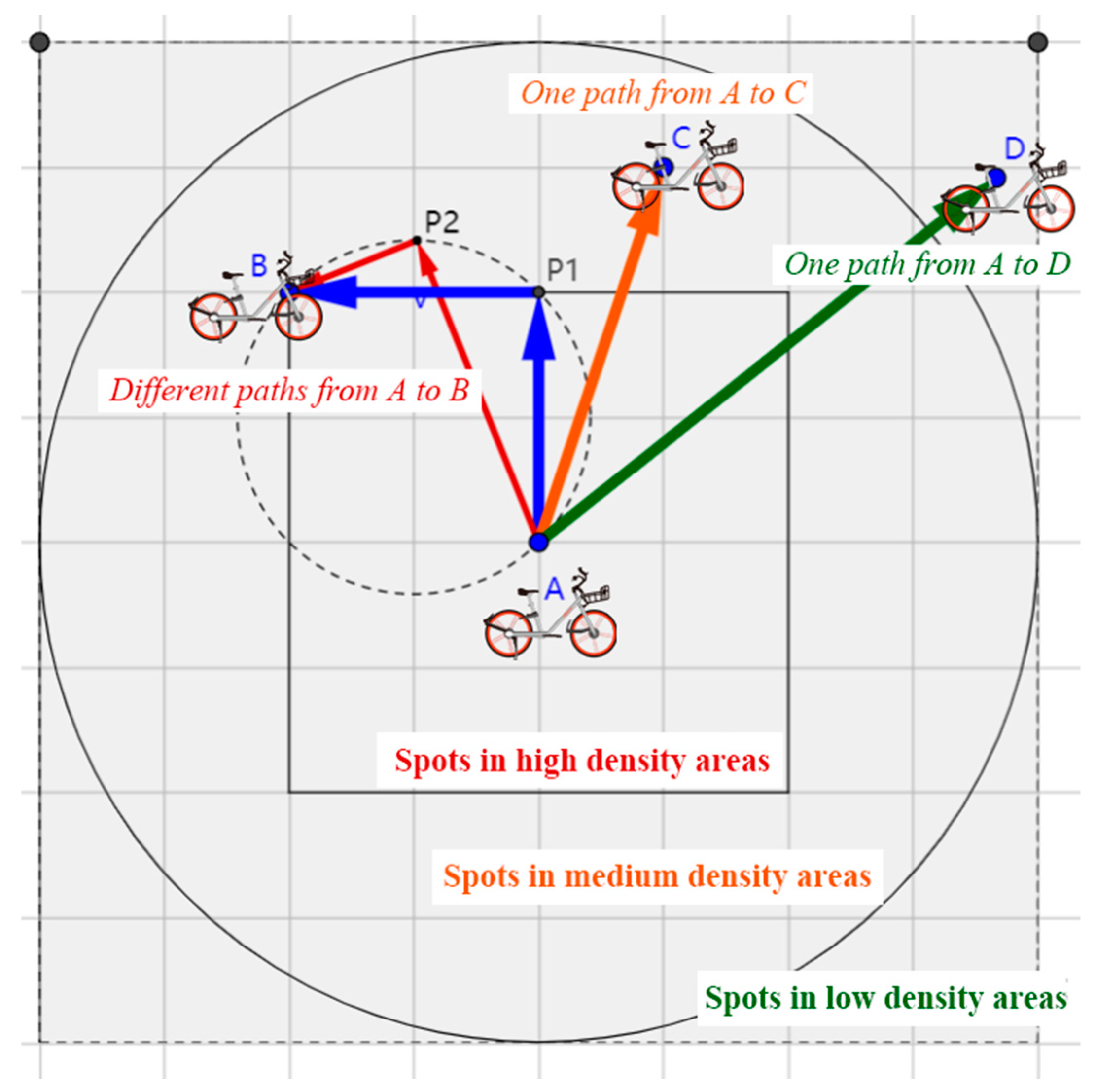
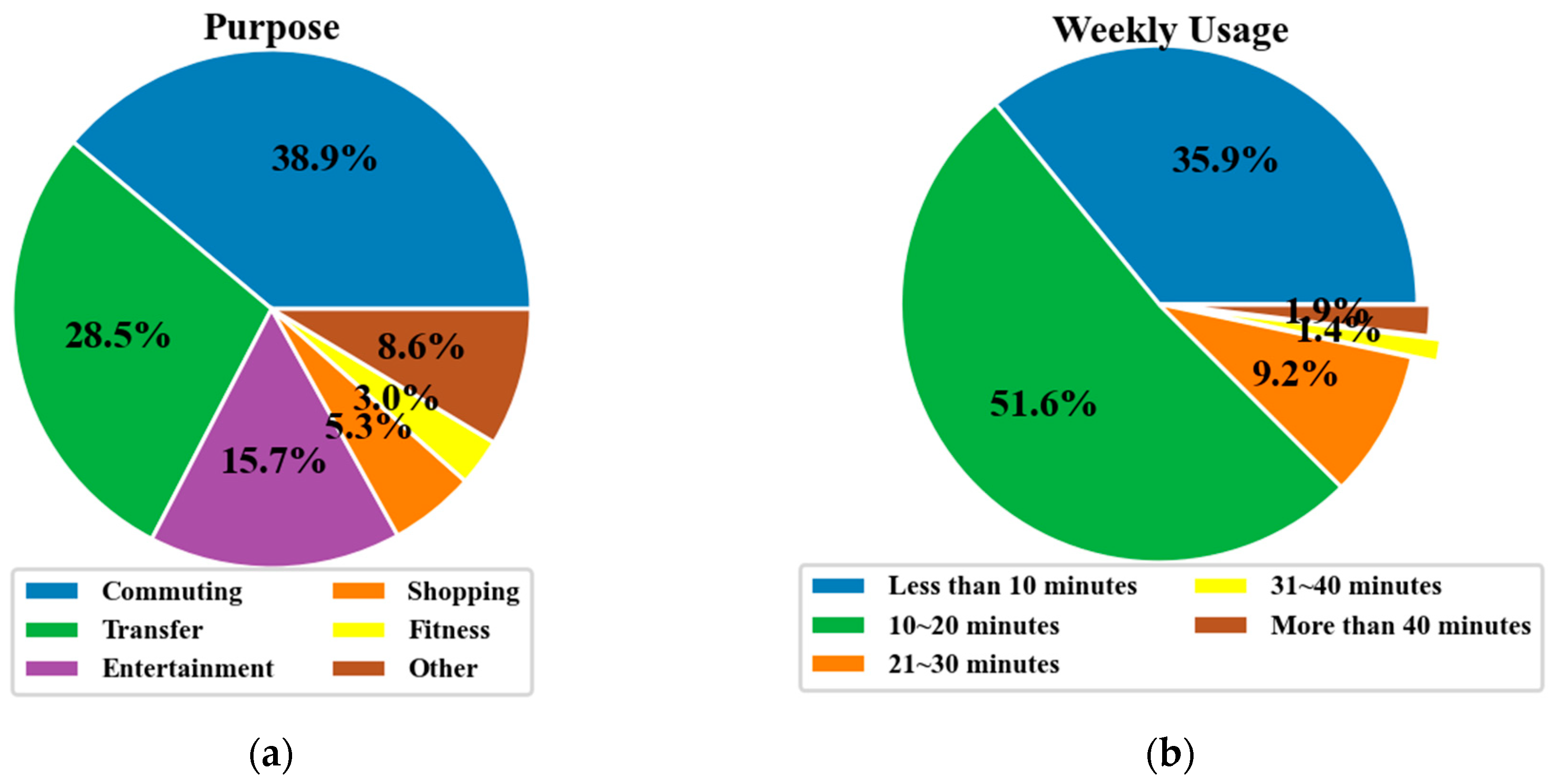
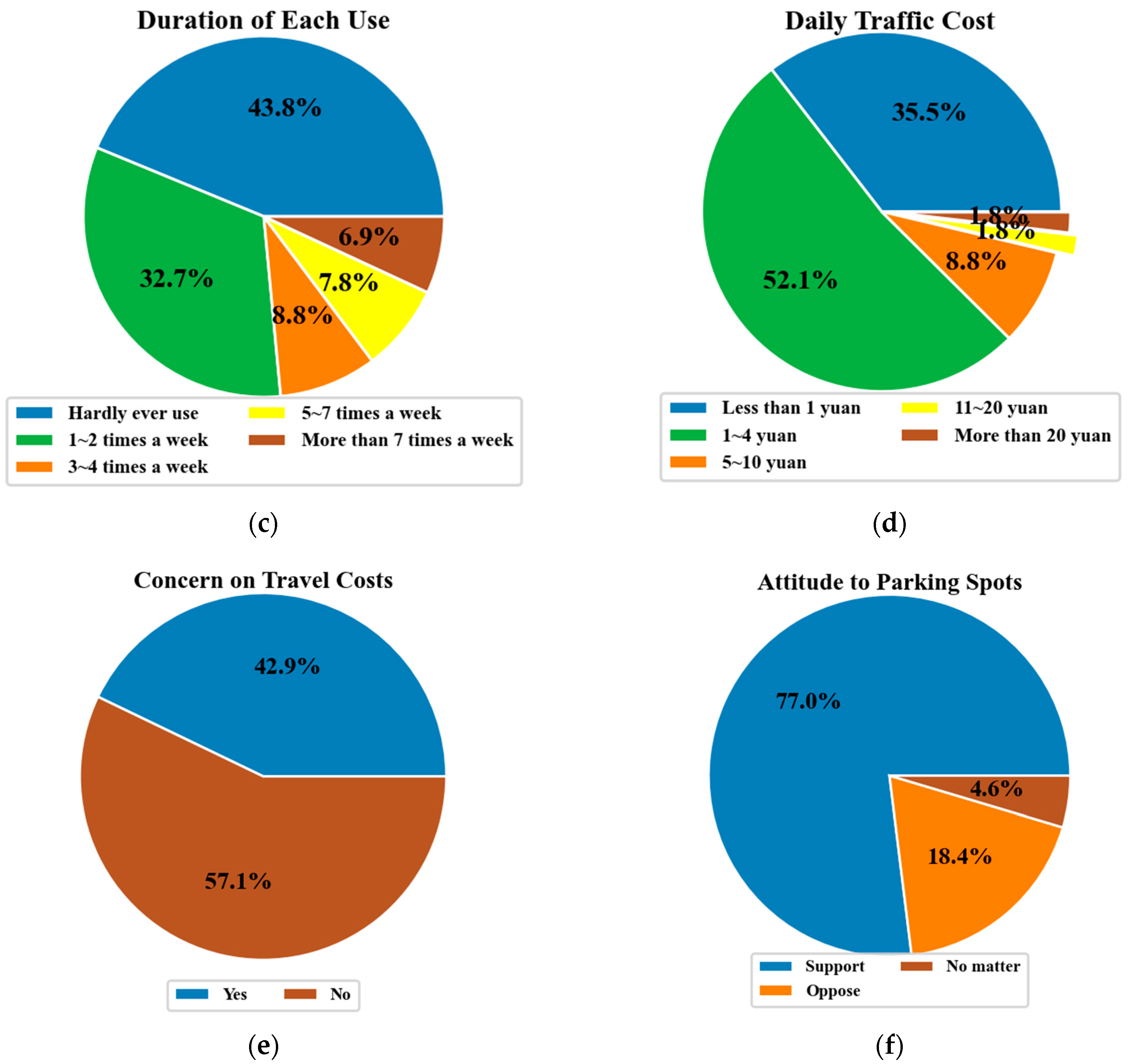
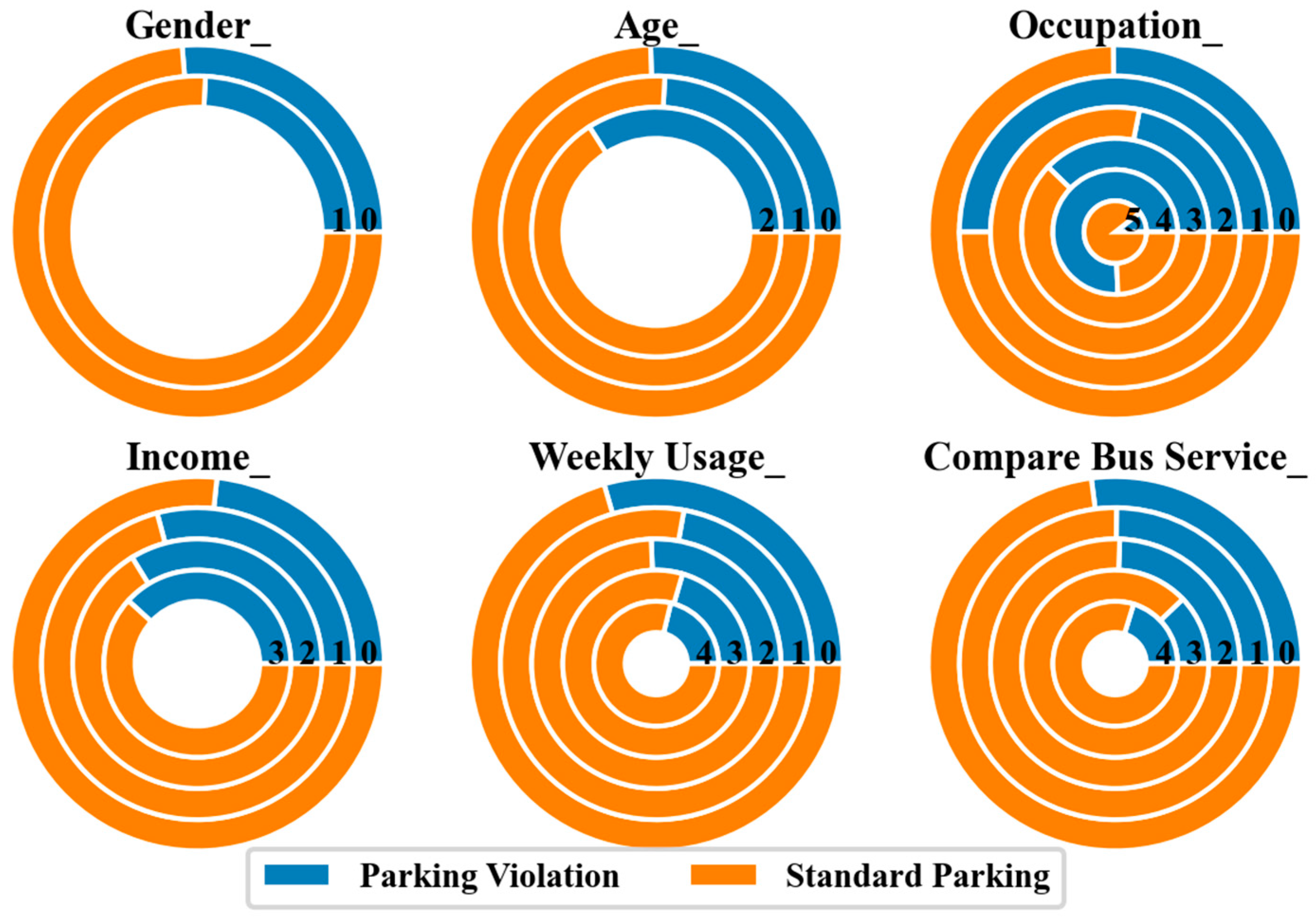
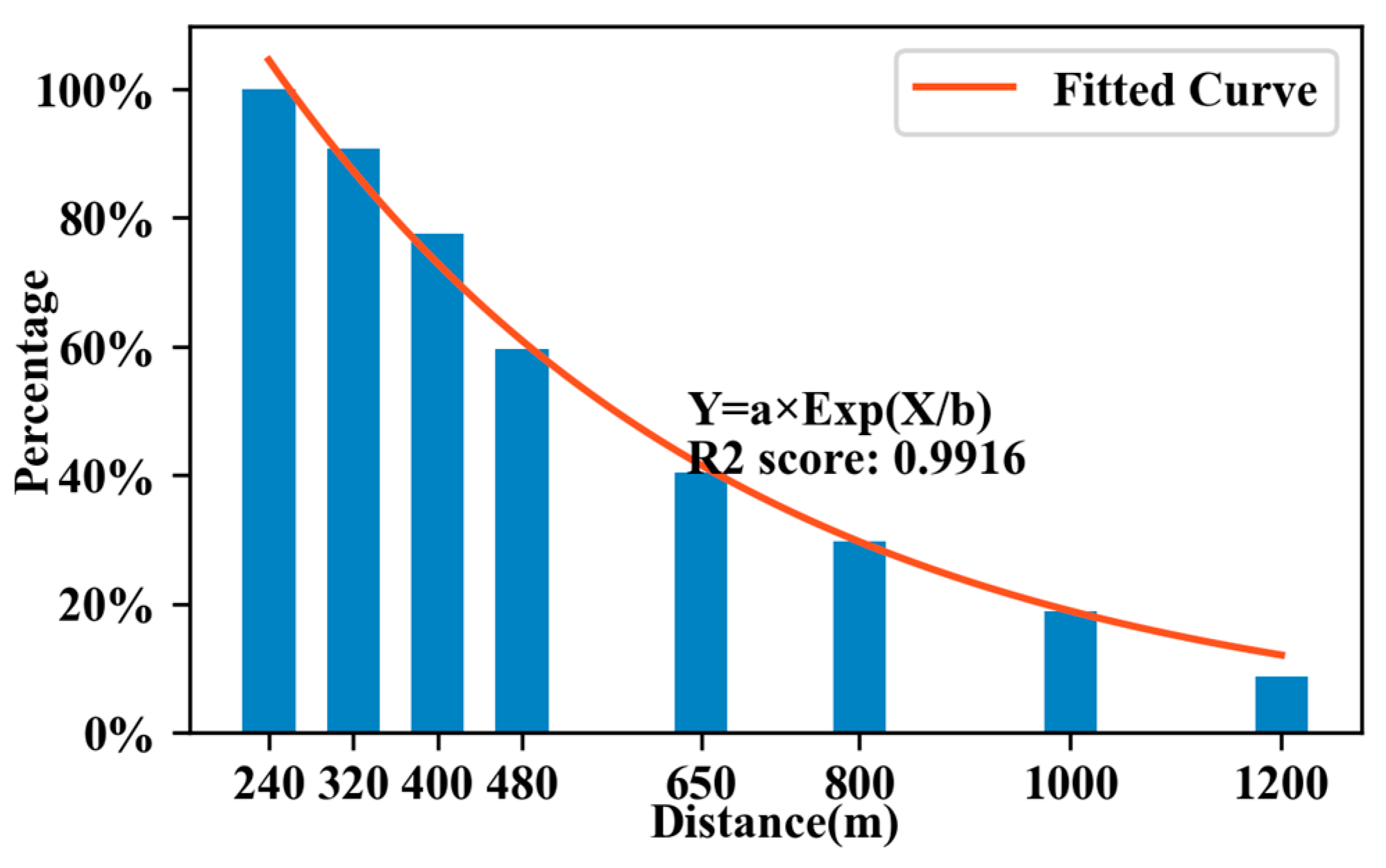
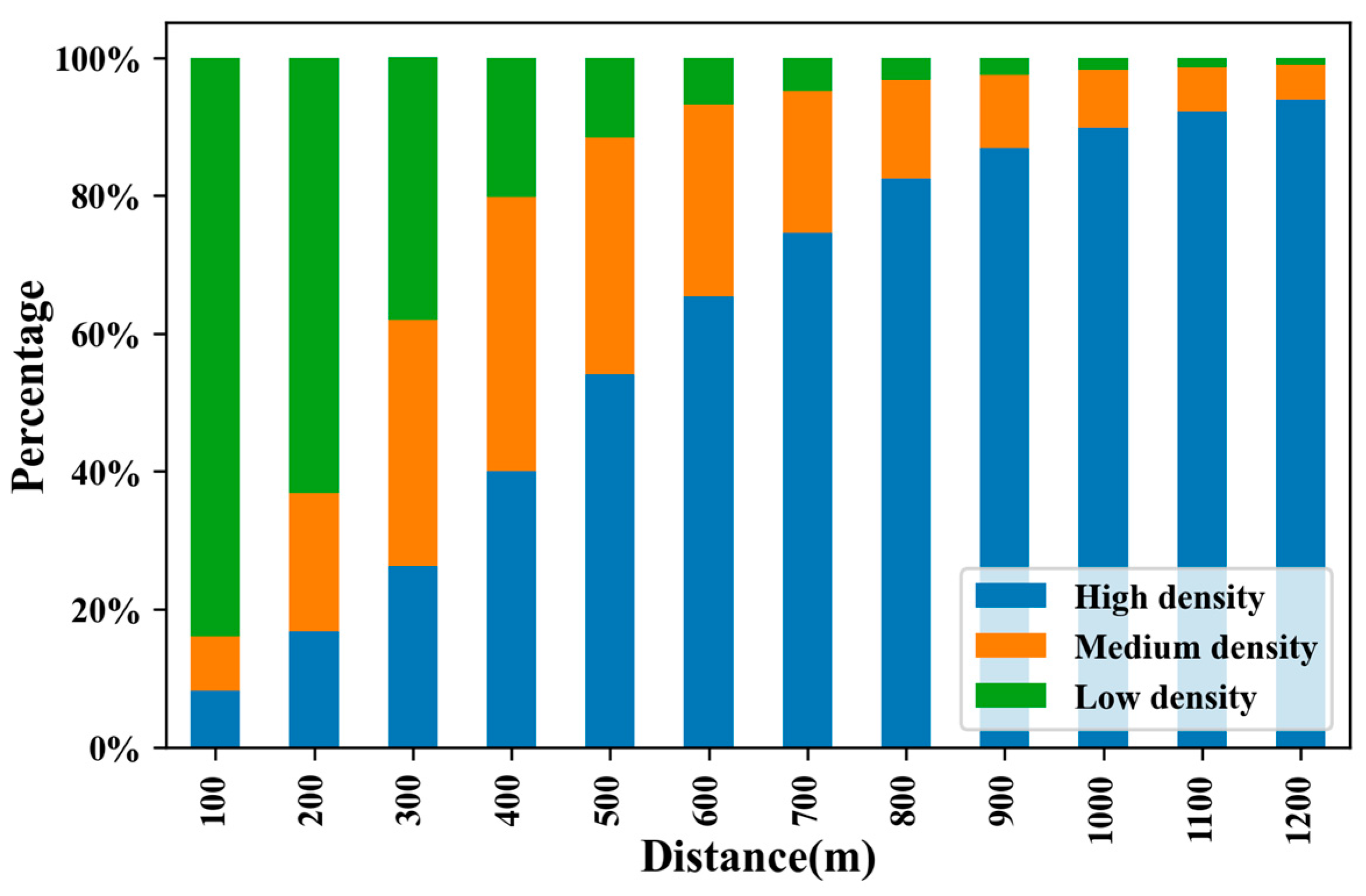

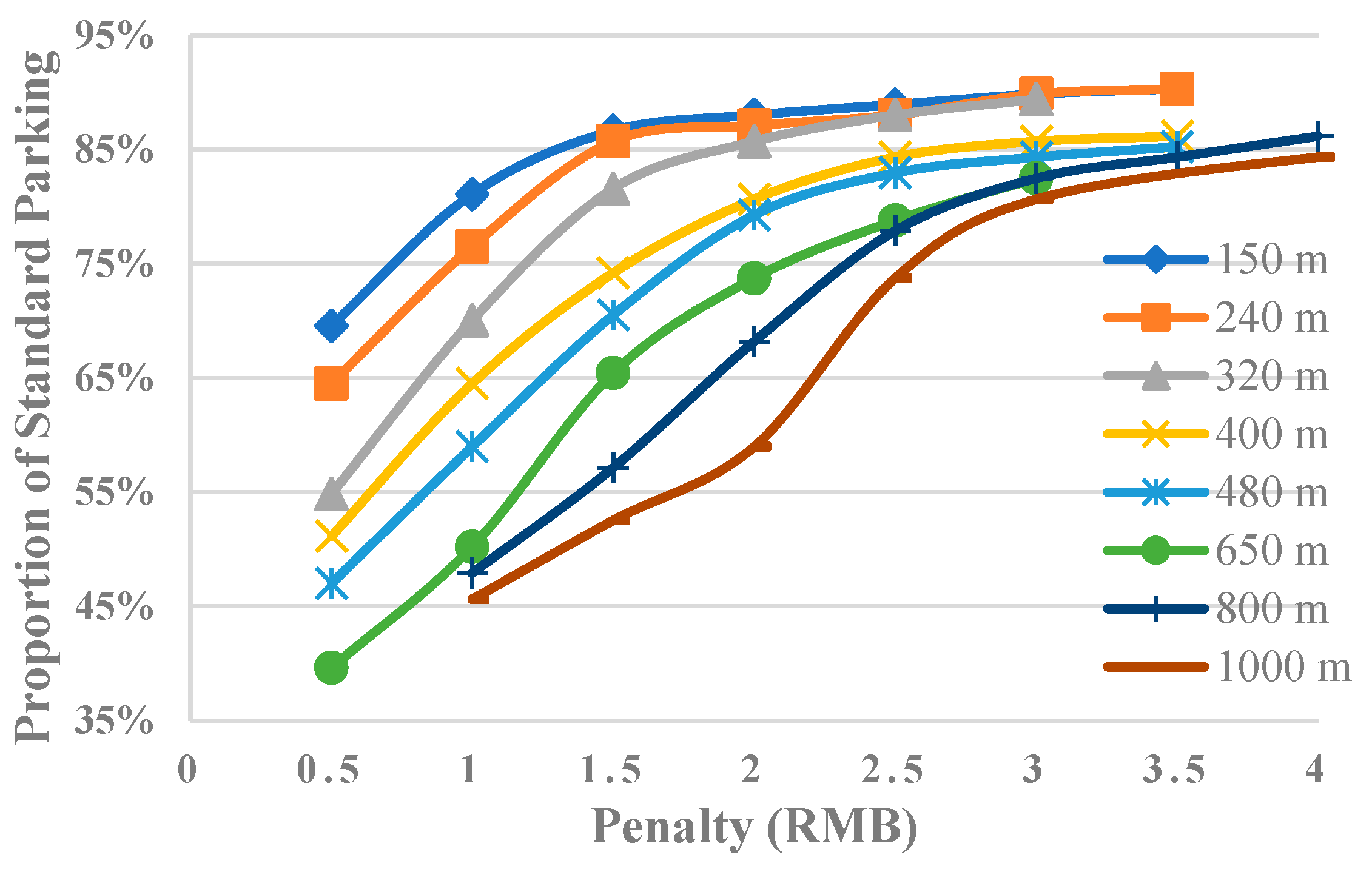
| Variable | Symbol | Encoding | Tolerance | VIF |
|---|---|---|---|---|
| Gender | GD | (0) Male; (1) Female | 0.871 | 1.149 |
| Age | AGE | (0) Under 17; (1) 18~25; (2) 26~25 (3) 45~60; (4) Above 60 | 0.680 | 1.470 |
| Occupation | OCP | (0) College students (1) Middle school students (2) Business employees (3) Public service workers (4) Freelancers; (5) Others | 0.630 | 1.587 |
| Income | ICM | (0) Under 5000; (1) 5000~8000 (2) 8000~10,000; (3) Above 10,000 | 0.647 | 1.545 |
| Purposes (Multiple choice) | PURP | (0) Commuting (1) Transfer (2) Entertainment (3) Shopping (4) Fitness (5) Other | 0.633 0.787 0.764 0.838 0.851 0.719 | 1.579 1.270 1.310 1.193 1.175 1.392 |
| Weekly usage | WU | (0) Hardly ever use; (1) 1~2 times a week (2) 3~4 times a week; (3) 5~7 times a week (4) More than 7 times a week | 0.837 | 1.194 |
| Compare bus service | CBS | (0) Within 150 m; (1) Half distance (2) Approximately same; (3) Twice the distance (4) More than twice the distance | 0.835 | 1.198 |
| Concern on travel costs | CTC | (0) No; (1) Yes | 0.908 | 1.101 |
| Attitude to parking spots | APS | (0) Support; (1) No matter; (2) Oppose | 0.905 | 1.104 |
| Duration of each use | DEU | Less than 10 min: 5 min 10~20 min: 15 min 21~30 min: 25 min 31~40 min: 35 min More than 40 min: 45 min | 0.832 | 1.202 |
| Daily traffic cost (public transport) | DTC | Less than 1 RMB: 0 RMB 1~4 RMB: 2.5 RMB 5~10 RMB: 7.5 RMB 11~20 RMB: 15 RMB. More than 20 RMB: 25 RMB | 0.858 | 1.165 |
| Maximum walking distance | MWD | 3 min: 240 m 4 min: 320 m 5 min: 400 m 6 min: 480 m 8 min: 650 m 10 min: 800 m 12 min: 1000 m Above 1000 m: 1200 m | 0.891 | 1.122 |
| Walking distance | WD | Original values | 0.877 | 1.141 |
| Fine | FIN | Original values | 0.877 | 1.141 |
| Mean | Var | St.D | Skewness | Kurtosis | |
|---|---|---|---|---|---|
| DEU | 13.16 | 63.889 | 7.993 | 1.372 | 3.253 |
| DTC | 2.696 | 16.582 | 4.0721 | 3.579 | 15.377 |
| MWD | 627.74 | 102,879.893 | 320.749 | 0.489 | −1.128 |
| WD | 500.83 | 71,097.798 | 266.642 | 0.464 | −0.959 |
| FIN | 1.990 | 1.089 | 1.0433 | 0.509 | −0.073 |
| Variable | B | S.E. | Wald | DOF | Significance | Exp (B) | 95% C.I. for Exp |
|---|---|---|---|---|---|---|---|
| GD (1) | −0.120 | 0.056 | 4.625 | 1 | 0.032 | 0.887 | 0.796~0.989 |
| AGE (0) | 19.319 | 2 | 0.000 | ||||
| AGE (1) | 0.504 | 0.119 | 17.810 | 1 | 0.000 | 1.655 | 1.310~2.091 |
| AGE (2) | 0.526 | 0.312 | 2.851 | 1 | 0.091 | 1.693 | 0.919~3.119 |
| OCP (0) | 239.283 | 5 | 0.000 | ||||
| OCP (1) | −0.167 | 0.424 | 0.155 | 1 | 0.694 | 0.846 | 0.368~1.944 |
| OCP (2) | 0.603 | 0.147 | 16.753 | 1 | 0.000 | 1.827 | 1.369~2.439 |
| OCP (3) | −0.458 | 0.162 | 8.012 | 1 | 0.005 | 0.632 | 0.460~0.868 |
| OCP (4) | −2.486 | 0.246 | 102.042 | 1 | 0.000 | 0.083 | 0.051~0.135 |
| OCP (5) | 1.442 | 0.172 | 70.341 | 1 | 0.000 | 4.231 | 3.020~5.926 |
| ICM (0) | 65.464 | 3 | 0.000 | ||||
| ICM (1) | −0.152 | 0.123 | 1.528 | 1 | 0.216 | 0.859 | 0.675~1.093 |
| ICM (2) | −0.755 | 0.119 | 40.399 | 1 | 0.000 | 0.470 | 0.372~0.593 |
| ICM (3) | −0.733 | 0.115 | 40.691 | 1 | 0.000 | 0.480 | 0.383~0.602 |
| WU (0) | 26.712 | 4 | 0.000 | ||||
| WU (1) | 0.127 | 0.062 | 4.159 | 1 | 0.041 | 1.135 | 1.005~1.282 |
| WU (2) | −0.034 | 0.098 | 0.116 | 1 | 0.734 | 0.967 | 0.797~1.173 |
| WU (3) | −0.148 | 0.116 | 1.628 | 1 | 0.202 | 0.862 | 0.687~1.083 |
| WU (4) | 0.534 | 0.119 | 20.148 | 1 | 0.000 | 1.706 | 1.351~2.155 |
| CBS (0) | 79.810 | 4 | 0.000 | ||||
| CBS (1) | −0.145 | 0.064 | 5.076 | 1 | 0.024 | 0.865 | 0.763~0.981 |
| CBS (2) | −0.163 | 0.074 | 4.906 | 1 | 0.027 | 0.850 | 0.735~0.981 |
| CBS (3) | 1.715 | 0.212 | 65.277 | 1 | 0.000 | 5.559 | 3.666~8.427 |
| CBS (4) | 0.307 | 0.196 | 2.452 | 1 | 0.117 | 1.360 | 0.926~1.998 |
| Commuting | Transfer | Entertainment | Shopping | Fitness | Other | |
|---|---|---|---|---|---|---|
| Parking violation | 25.1% | 25.4% | 23.0% | 13.2% | 23.1% | 27.9% |
| Standard parking | 74.9% | 74.6% | 77.0% | 86.8% | 76.9% | 72.1% |
| Response rate | 38.9% | 28.5% | 15.7% | 5.3% | 3.0% | 8.6% |
| Variable | B | S.E. | Wald | Significance | Exp (B) | 95% C.I. for Exp |
|---|---|---|---|---|---|---|
| DEU | 0.022 | 0.004 | 36.971 | 0.000 | 1.022 | 1.015~1.030 |
| DTC | −0.068 | 0.007 | 90.664 | 0.000 | 0.934 | 0.922~0.948 |
| MWD | 0.002 | 0.000 | 309.477 | 0.000 | 1.002 | 1.001~1.002 |
| WD | −0.002 | 0.000 | 397.092 | 0.000 | 0.998 | 0.998~0.998 |
| FIN | 0.796 | 0.028 | 803.130 | 0.000 | 2.216 | 2.097~2.341 |
| Distance d | High Density Phd | Medium Density Pmd | Low Density Pld | Service Level P(s ≤ d) | Use Efficiency P(ds|s ≤ d) |
|---|---|---|---|---|---|
| 100 m | 8.21% | 7.89% | 83.90% | 11.44% | 71.74% |
| 200 m | 16.82% | 20.06% | 63.11% | 25.04% | 67.16% |
| 300 m | 26.26% | 35.66% | 38.08% | 40.88% | 64.24% |
| 400 m | 40.09% | 39.66% | 20.24% | 56.35% | 71.14% |
| 500 m | 54.11% | 34.29% | 11.60% | 68.17% | 79.38% |
| 600 m | 65.38% | 27.85% | 6.77% | 76.80% | 85.13% |
| 700 m | 74.57% | 20.50% | 4.94% | 82.98% | 89.87% |
| 800 m | 82.49% | 14.19% | 3.31% | 88.31% | 93.41% |
| 900 m | 86.92% | 10.59% | 2.49% | 91.26% | 95.24% |
| 1000 m | 89.88% | 8.29% | 1.84% | 93.28% | 96.36% |
| 1100 m | 92.22% | 6.45% | 1.33% | 94.86% | 97.21% |
| 1200 m | 93.88% | 5.12% | 1.01% | 95.98% | 97.81% |
| Walking Distance Level | Distance from the Nearest Parking Spot (m) | Amount of Penalty (Credit Score) |
|---|---|---|
| Level 1 | <100 | ¥0 and 2 credit score |
| Level 2 | 100~300 | ¥1 or 6 credit score |
| Level 3 | 300~500 | ¥2 or 15 credit score |
| Level 4 | 500~800 | ¥3 |
| Level 5 | >800 | ¥5 |
| Credit score: +1/standard parking, and zero at the end of the month. | ||
| Serial Number | Minimum Distance (m) | Walking Distance Level | Original (%) | Current (%) | Improvement (%) |
|---|---|---|---|---|---|
| POI_22 | 1 | Level 1 | 100.00 | 100.00 | 0.00 |
| POI_24 | 1 | Level 1 | 100.00 | 100.00 | 0.00 |
| POI_14 | 509 | Level 1 | 69.59 | 69.59 | 0.00 |
| POI_12 | 50 | Level 1 | 69.59 | 69.59 | 0.00 |
| POI_17 | 73 | Level 1 | 69.59 | 69.59 | 0.00 |
| POI_00 | 149 | Level 2 | 69.59 | 81.34 | 11.75 |
| POI_15 | 158 | Level 2 | 69.59 | 80.89 | 11.30 |
| POI_08 | 169 | Level 2 | 64.52 | 80.34 | 15.82 |
| POI_16 | 226 | Level 2 | 64.52 | 77.49 | 12.97 |
| POI_21 | 240 | Level 2 | 64.52 | 76.79 | 12.27 |
| POI_11 | 249 | Level 2 | 64.52 | 76.34 | 11.82 |
| POI_06 | 272 | Level 2 | 54.84 | 75.19 | 20.35 |
| POI_19 | 278 | Level 2 | 54.84 | 74.89 | 20.05 |
| POI_23 | 327 | Level 3 | 54.84 | 84.28 | 29.44 |
| POI_09 | 368 | Level 3 | 51.15 | 83.05 | 31.90 |
| POI_13 | 408 | Level 3 | 51.15 | 81.85 | 30.70 |
| POI_18 | 431 | Level 3 | 51.15 | 81.16 | 30.01 |
| POI_01 | 440 | Level 3 | 47.00 | 80.89 | 33.89 |
| POI_10 | 481 | Level 3 | 47.00 | 79.66 | 32.66 |
| POI_05 | 509 | Level 4 | 47.00 | 82.50 | 35.50 |
| POI_07 | 517 | Level 4 | 39.63 | 82.42 | 42.79 |
| POI_20 | 760 | Level 4 | 39.63 | 79.99 | 40.36 |
| POI_04 | 864 | Level 5 | 37.36 | 86.18 | 48.82 |
| POI_03 | 883 | Level 5 | 37.36 | 86.18 | 48.82 |
| POI_02 | 1010 | Level 5 | 27.36 | 86.18 | 58.82 |
| Mean | 57.85 | 81.05 | 23.20 | ||
Disclaimer/Publisher’s Note: The statements, opinions and data contained in all publications are solely those of the individual author(s) and contributor(s) and not of MDPI and/or the editor(s). MDPI and/or the editor(s) disclaim responsibility for any injury to people or property resulting from any ideas, methods, instructions or products referred to in the content. |
© 2023 by the authors. Licensee MDPI, Basel, Switzerland. This article is an open access article distributed under the terms and conditions of the Creative Commons Attribution (CC BY) license (https://creativecommons.org/licenses/by/4.0/).
Share and Cite
Bao, J.; Chen, G.; Liu, Z. Exploring the Influence of Parking Penalties on Bike-Sharing System with Willingness Constraints: A Case Study of Beijing, China. Sustainability 2023, 15, 12526. https://doi.org/10.3390/su151612526
Bao J, Chen G, Liu Z. Exploring the Influence of Parking Penalties on Bike-Sharing System with Willingness Constraints: A Case Study of Beijing, China. Sustainability. 2023; 15(16):12526. https://doi.org/10.3390/su151612526
Chicago/Turabian StyleBao, Jiayu, Guojun Chen, and Zhenghua Liu. 2023. "Exploring the Influence of Parking Penalties on Bike-Sharing System with Willingness Constraints: A Case Study of Beijing, China" Sustainability 15, no. 16: 12526. https://doi.org/10.3390/su151612526
APA StyleBao, J., Chen, G., & Liu, Z. (2023). Exploring the Influence of Parking Penalties on Bike-Sharing System with Willingness Constraints: A Case Study of Beijing, China. Sustainability, 15(16), 12526. https://doi.org/10.3390/su151612526






